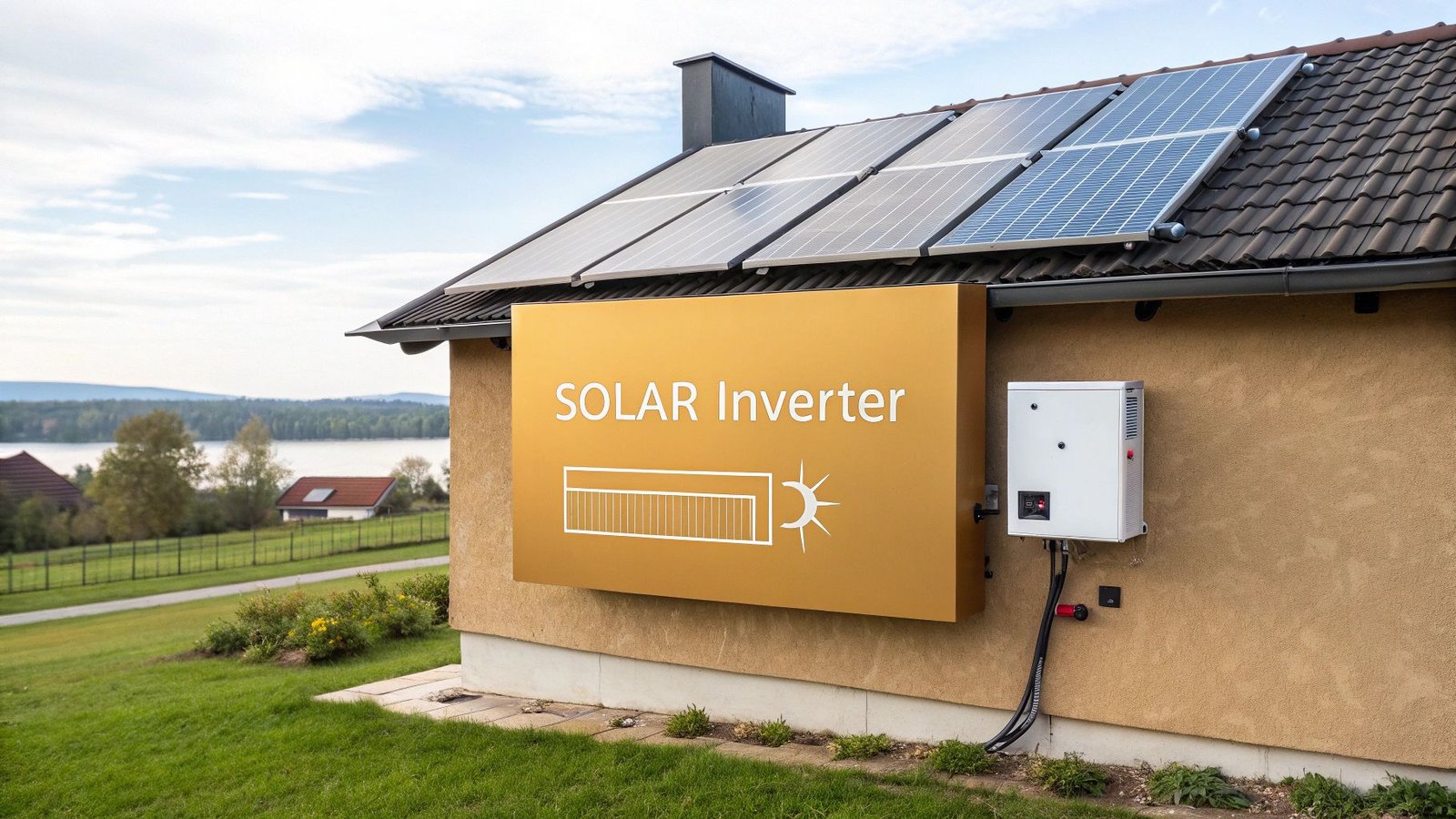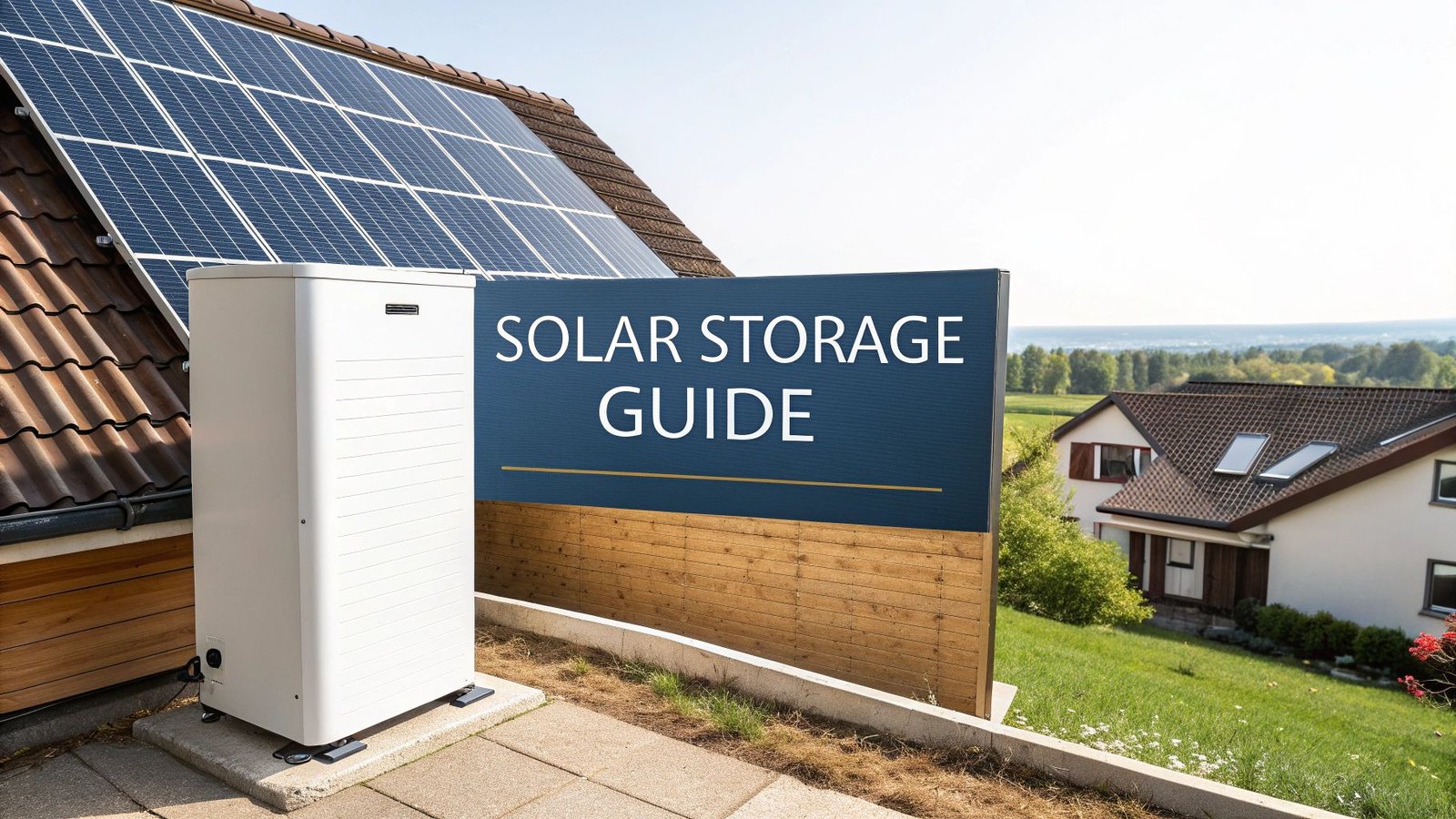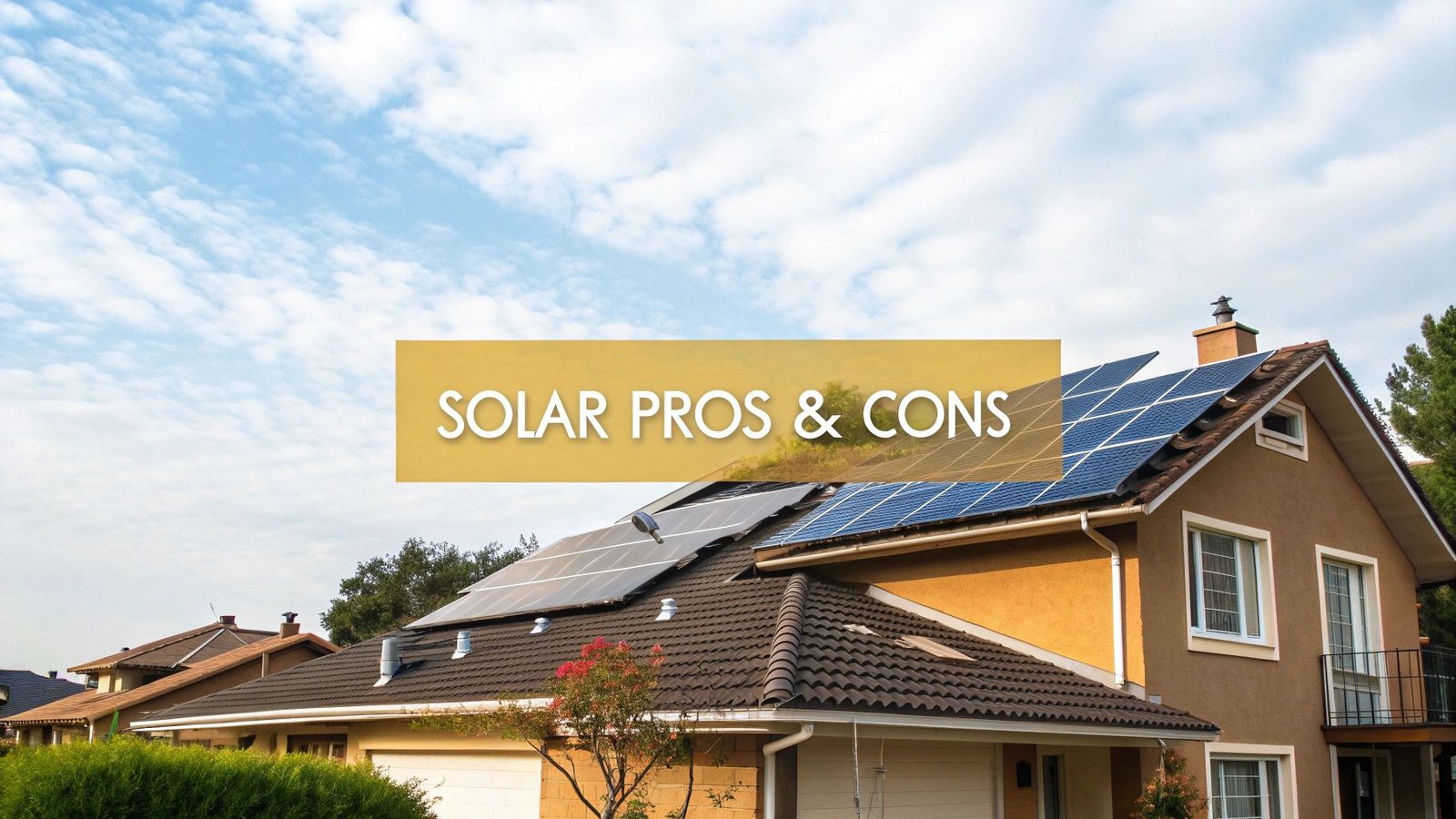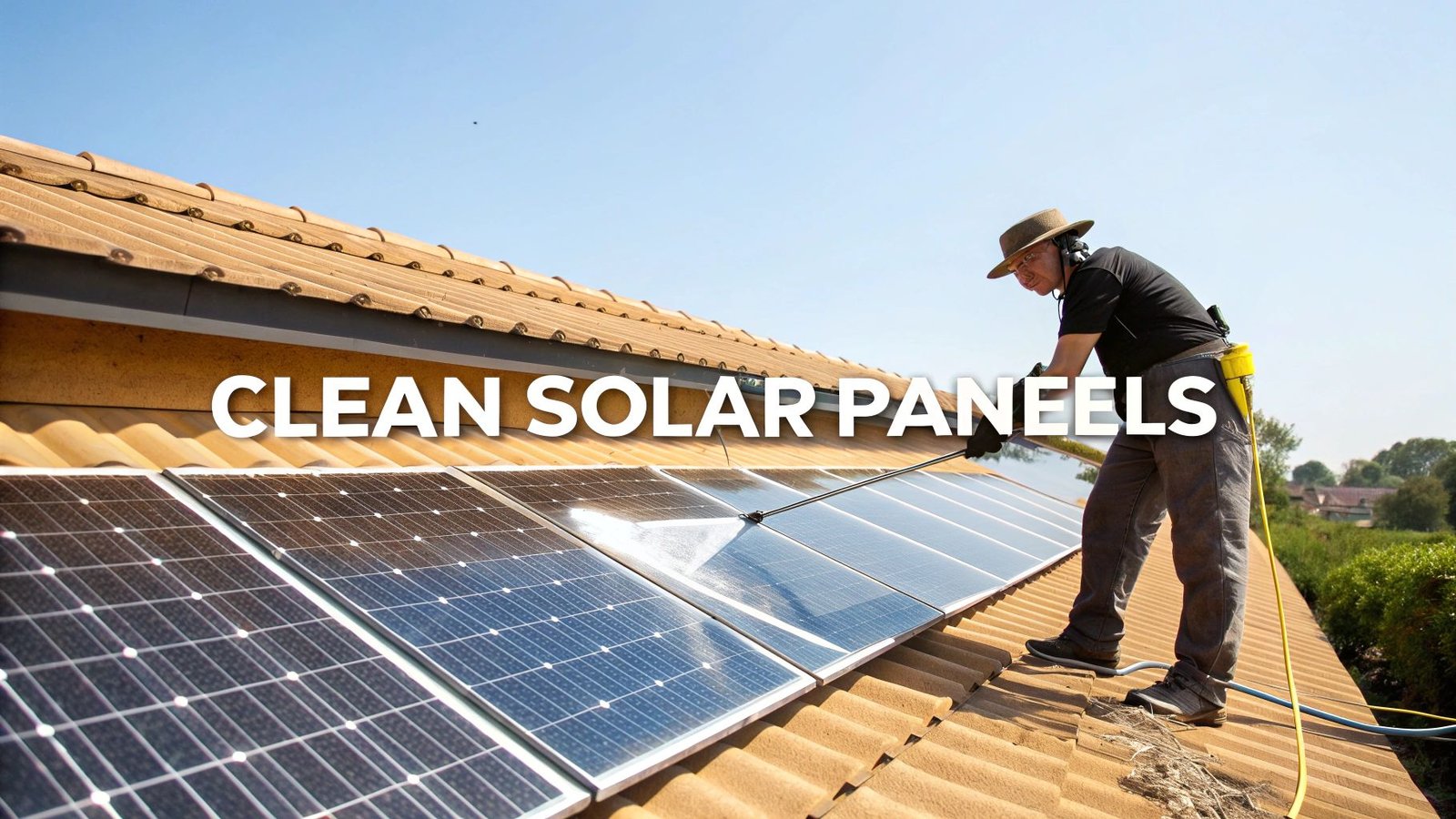If you think of your solar panels as the heart of your solar energy system, diligently collecting raw power from the sun, then the solar inverter is the brain. It's the essential piece of hardware that takes the electricity your panels generate and makes it useful for your home.
Without it, all that captured sunlight is essentially useless.
The Brains Behind Your Solar Power

Here's why: your solar panels produce direct current (DC) electricity, where the energy flows in a single direction. But your home's electrical grid and every appliance you own—from the coffee maker to your TV—runs on alternating current (AC). They're fundamentally incompatible.
The solar inverter bridges this gap. It's an electrical translator, taking that raw DC power and converting it into the AC power your home can actually use. In a way, it’s what connects your solar panels to the rest of your life.
But the job doesn't stop at simple conversion. Modern inverters are smart devices that manage your entire system. They constantly work to maximize the power output from your panels, monitor the system's health, and ensure everything operates safely. The inverter's efficiency is a huge factor in your system's overall performance and, ultimately, your return on investment. You can learn more about the evolution of the global solar inverter market to see how far this technology has come.
Solar Inverter Quick Facts
To put it all in perspective, here’s a quick summary of what a solar inverter does and why it's so important.
| Key Function | Input Electricity | Output Electricity | Analogy | Core Importance |
|---|---|---|---|---|
| Converts DC power to AC power | Direct Current (DC) | Alternating Current (AC) | An electrical translator | Makes solar energy usable for homes and the grid |
This simple conversion is what truly unlocks the power of the sun for everyday use.
How Solar Inverters Turn Sunlight Into Electricity
Ever wondered how a sunbeam hitting your roof actually powers your laptop? That magical transformation happens thanks to a solar inverter, the real workhorse of your solar energy system.
Your solar panels are great at capturing sunlight, but the electricity they produce is direct current (DC). Think of DC power as a one-way street—a steady, flat line of energy. The problem? Your home’s appliances and the entire electrical grid run on a completely different kind of power.
Everything in your house, from the TV to the toaster, needs alternating current (AC). AC power is more like a rhythmic, back-and-forth wave. The inverter’s main job is to take that straight-line DC power from the panels and skillfully convert it into the wavy AC power your home can actually use. It’s essentially an energy translator.
The DC to AC Conversion Process
So, how does it pull this off? The inverter acts like an incredibly fast, intelligent switch. By rapidly reversing the flow of the DC electricity, it creates a fluctuating current. This raw output is then smoothed out by sophisticated electronics inside the inverter, producing the clean, stable AC sine wave needed to safely power your life.
This quick visual breaks down the journey from the sun to your socket.

As you can see, the inverter is the critical link between the raw solar energy collected by the panels and the usable electricity that flows through your outlets and out to the grid.
Lo más importante: The inverter doesn't just flip a switch. It intelligently manages the flow of energy to ensure the power coming into your home is stable, safe, and efficient. Without it, the sun's power would be stuck on your roof.
This conversion process is the heart of any functional solar setup. To see how this piece fits into the larger puzzle, check out our guide on how home solar works. At the end of the day, the inverter is what makes the sun’s energy speak the same electrical language as your home.
Comparing Solar Inverter Types
So, you're looking into solar panels, but have you thought about the inverter? It's easy to overlook, but choosing the right one is like picking the right engine for a car—it's absolutely critical for getting the most out of your system. Not all solar inverters are built the same, and the best choice really depends on your specific roof, your budget, and what you want to achieve.
You'll mainly come across three options: string inverters, microinvertersy optimizadores de potencia. Each one takes a different approach to converting that DC power from your panels into the AC power your home uses. This choice has a huge impact on your system's efficiency, especially if you have trees casting shadows or parts of your roof facing different directions.

String Inverters: The Classic Approach
Think of a string inverter as the workhorse of the solar world. It’s the most common and budget-friendly option out there. The setup is straightforward: a group of panels are wired together in a series (a "string"), and all their combined DC power flows down to a single, central inverter box. This box, usually tucked away in your garage or on the side of the house, does the conversion job all at once.
For homes with a simple, wide-open roof that gets consistent sun all day, this system works like a charm. But there's a catch. The entire string is only as strong as its weakest link. If even one panel gets covered by shade, the output of every other panel on that string drops to match it. It's just like those old holiday lights—when one bulb goes out, the whole string goes dark.
Microinverters And Power Optimizers
For trickier roofs, microinverters and power optimizers are a smarter way to go. Instead of one big inverter, a microinverter system puts a tiny, dedicated inverter on the back of every single panel. This means each panel becomes its own independent power-producing unit, converting DC to AC right on the spot.
A key benefit of this panel-level optimization is that shading or poor performance from one panel has zero impact on the others. This makes microinverters a perfect fit for roofs with partial shade, multiple angles, or obstructions like chimneys.
Power optimizers are a clever hybrid. Like microinverters, a small device is attached to each panel, but its job is to condition the DC power, not convert it. It "optimizes" the electricity before sending it down to a central string inverter that handles the final DC-to-AC conversion. You get the panel-level benefits of a microinverter setup but often at a lower cost. As you might imagine, the global solar market is buzzing with innovation, with different regions favoring different technologies. You can learn more about the dominant trends in the solar inverter market to see how the industry is evolving.
Comparing Solar Inverter Technologies
To make the choice a little clearer, let's break down how these three technologies stack up against each other. This chart gives you a quick, visual look at the pros and cons of each.
graph TD
subgraph A[String Inverter]
style A fill:#f9f,stroke:#333,stroke-width:2px
A1(Ideal For: Simple, unshaded roofs)
A2(Cost: Low)
A3(Challenge: Performance limited by weakest panel)
end
subgraph B[Microinverter]
style B fill:#ccf,stroke:#333,stroke-width:2px
B1(Ideal For: Complex or shaded roofs)
B2(Cost: High)
B3(Benefit: Each panel is independent)
end
subgraph C[Power Optimizer]
style C fill:#cfc,stroke:#333,stroke-width:2px
C1(Ideal For: Roofs with some shading)
C2(Cost: Moderate)
C3(Benefit: Panel-level optimization with central inverter)
end
Ultimately, the right technology depends on your unique situation. A simple, south-facing roof might be perfectly served by a cost-effective string inverter, while a more complex roof will see a much better return with microinverters or optimizers.
How to Choose the Right Solar Inverter
Picking the right solar inverter is about more than just a brand name. Think of it as matching the brain of your solar system to your home's unique energy needs and your plans for the future. The right choice will squeeze every possible watt out of your panels, run reliably for years, and give you a clear window into how your system is performing.
First things first, look at the inverter's índice de eficiencia. This number shows you how good the inverter is at converting the raw DC power from your panels into the AC power your home uses. The difference between 96% y 98% efficiency might not sound like much, but over the 25 años life of your solar panels, that tiny gap can add up to a surprising amount of saved energy.

Key Features to Compare
Beyond raw efficiency, a few other things really matter. The warranty is a big one. You'll find that most inverters come with a standard 10-12 year warranty. However, some of the top-tier brands offer extensions that can take you all the way up to 25 years, matching the lifespan of your solar panels and giving you serious peace of mind.
Another huge factor is the monitoring system. A good modern inverter comes with an app or a web portal that shows you exactly what your system is doing. You can track your energy production in real-time, see how much power each panel is making, and spot any potential issues long before they become big problems.
The chart below visualizes the typical warranty lengths you can expect.
gantt
title Typical Solar Inverter Warranty Durations
dateFormat YYYY
axisFormat %Y Years
section String Inverter
Standard Warranty :a1, 2024, 12y
Extended Warranty :after a1, 3y
section Microinverter / Optimizer
Standard Warranty :2024, 25y
- Battery Compatibility: Is the inverter just a standard grid-tie model, or is it a "hybrid" inverter? If you think you might want to add a battery down the road, a hybrid model will make that transition seamless.
- Warranty Length: Don't just glance at the number. Compare the standard warranty and see what it costs to extend it. A longer warranty is a vote of confidence from the manufacturer.
- Monitoring Platform: Take a look at the app or dashboard. Is it easy to use? Does it give you the detailed, panel-level data you’re curious about?
Consejo profesional: Your inverter has to be the right size for your solar panel array. If it's too small, it will "clip" off the extra power your panels produce on really sunny days, which is just wasted energy. If it's too big, it won't operate as efficiently.
Nailing this balance is key to getting the most out of your investment. If you're wondering how to figure out the right size, our guide on how to size a solar system is the perfect place to start. In the end, the best inverter is the one that’s a perfect fit for your home, your budget, and your energy goals.
Smart and Hybrid Solar Inverters
Today's solar inverters are a far cry from the simple power converters of the past. Think of them less as a component and more as the intelligent brain of your entire home energy system—a central hub that makes your home more resilient and ready for the future. These smart devices are actively managing how your home interacts with the grid, communicating with utilities, and even integrating with other smart home technology.
This evolution is really driven by two key players: smart inverters y hybrid inverters. While a smart inverter acts like a savvy grid manager, a hybrid model gives you a direct path toward true energy independence.
The Rise of Intelligent Energy Management
If you're even remotely interested in adding battery storage, the hybrid inverter is a game-changer. These inverters come with a battery charger built right in, which completely simplifies the process of adding a home battery. This all-in-one design makes it much easier to figure out how to store solar energy and prepare for outages, without having to deal with a complicated and expensive retrofit down the road.
Beyond just storage, the newest inverters are getting seriously smart, using advanced analytics to squeeze every last drop of performance out of your panels.
Market growth is strongly influenced by the integration of artificial intelligence (AI) technologies which optimize inverter performance by analyzing solar irradiance, weather conditions, and predictive maintenance needs.
This AI-powered brain can spot potential problems before they ever affect your system's output, making sure you’re always getting the most from your solar investment. You can dive deeper into how AI is shaping the solar market to see where this is all heading.
To really get a feel for how they differ, let's break down their core jobs.
| Característica | Smart Inverter | Hybrid Inverter |
|---|---|---|
| Primary Focus | Grid interaction and communication | Battery integration and energy storage |
| Key Benefit | Supports grid stability and smart home integration | Provides a simple path to backup power and energy independence |
| Lo mejor para | Homeowners wanting advanced system control and monitoring | Homeowners planning to add battery storage now or in the future |
It's clear that the modern inverter has moved on from its old job. It’s no longer just a converter; it's the command center for a sophisticated home energy ecosystem.
Respuestas a sus principales preguntas sobre inversores de conexión a red
Alright, let's tackle some of the common questions that pop up when you're getting down to the nitty-gritty of planning a solar installation.
How Long Does a Solar Inverter Last?
This is a big one. Think of it this way: your solar panels are built to last a long time, and your inverter's lifespan should ideally line up.
A good quality inversor monofásico will typically give you De 10 a 15 años of solid performance. Most manufacturers back this up with a standard 10-12 year warranty, and you can often pay a bit extra to extend it.
Por otro lado, microinverters y optimizadores de potencia often come with a 25-year warranty, designed to match the lifespan of the panels themselves. Keep that warranty in mind—the inverter is one of the hardest-working parts of your system and one of the most likely to need attention down the road.
Where Does the Inverter Go?
You'll want to give your inverter a good home where it can stay cool, dry, and has some room to breathe. Proper ventilation is key to keeping it running efficiently.
Good spots usually include a garage, a utility room, or even a shaded spot on an exterior wall. Keeping it out of the direct sun helps prevent overheating, which can sap its performance and shorten its life.
Can I Add Batteries Later?
Absolutely. You're not locked out of battery storage if you don't get it on day one. This flowchart shows the two main paths for adding a battery to an existing solar system.
graph TD
A[Start with Solar Panels] --> B{Have a Hybrid Inverter?};
B -- Yes --> C[Directly Connect Battery];
B -- No --> D[Add an AC-Coupled<br>Battery System];
C --> E[Enjoy Backup Power];
D --> E;
If you have a standard string inverter, you can add batteries later using a method called AC coupling. This just means adding a separate, dedicated battery inverter to your setup. An even simpler route is to start with a hybrid inverter. These are designed to be "battery-ready" from the get-go, with all the necessary connections built right in.
What If My Inverter Fails? If your system stops producing power, don't panic. First, check for simple things like a tripped breaker. If that's not it, call your installer right away. They'll know exactly how to diagnose the problem and can handle the warranty claim for you if a replacement is needed.
Getting these details straight helps you know exactly what to expect from your system long after the installation crew has packed up and gone.
Ready to power your home with the sun? The experts at Energía radiante can design a custom solar solution with the perfect inverter to meet your needs. Get your free solar quote today!




